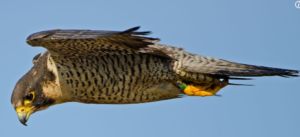 Although the anti-drone industry finally admitted that raptors aren’t amazing drone hunters, a new study has found that bird-brain behavior may launch new strategies for UAV mitigation.
Although the anti-drone industry finally admitted that raptors aren’t amazing drone hunters, a new study has found that bird-brain behavior may launch new strategies for UAV mitigation.
Funded by the U.S. Air Force, the Oxford University study found that peregrine falcons mimic the tactics of a guided missile when pursuing prey – a strategy that could be programmed into future anti-drone systems.
Previously, researchers believed the birds pf prey followed “simple geometric rules” whilst hunting – according to an Oxford press release.
“Falcons are classic aerial predators, synonymous with agility and speed. Our GPS tracks and on-board videos show how peregrine falcons intercept moving targets that don’t want to be caught,” Oxford researcher Graham Taylor said.
He explains:
“Remarkably, it turns out that they do this in a similar way to most guided missiles. Our next step is to apply this research to designing a new kind of visually guided drone, able to remove rogue drones safely from the vicinity of airports, prisons and other no-fly zones.”
The project showed that the bird’s inborn guidance system optimizes for lower flights speeds – the ideal tactic for finding and neutralizing rogue drones.
“It was very exciting to study these sleek, formidable aerial predators, and to watch them as they chased down our maneuvering lure towed behind a small remote-controlled airplane – then, through our computer modelling, to reveal the secret of their attack strategy,” study co-author and Oxford zoologist Caroline Brighton said.
Continuing research is finding numerous similarities between animal behavior and drone operation.
The U.S. Department of Defense is studying the behavior of bats and flying insects as it may apply to autonomous drones that “have significant improvements in maneuverability, survivability and stealth over traditional quadcopter or fixed wing designs.”
In 2015, MIT researchers developed drones that mimic the speed and behavior of flying insects.
In the wake of a small number of rogue drones behaving badly – such as a recent collision with military helicopters – the UAV mitigation industry could find the new research valuable in future development. A 2016 report by Grandview Research predicts that the anti-drone market will reach 1.85 billion by 2024.
Jason is a longstanding contributor to DroneLife with an avid interest in all things tech. He focuses on anti-drone technologies and the public safety sector; police, fire, and search and rescue.
Beginning his career as a journalist in 1996, Jason has since written and edited thousands of engaging news articles, blog posts, press releases and online content.
Email Jason
TWITTER:@JasonPReagan
Subscribe to DroneLife here.







[…] Falcon-flight Research May Inform Anti-drone Solutions. […]